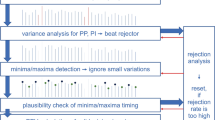Abstract
A continuous, noninvasive device for blood pressure measurement using pulse transit time has been recently introduced. We compared blood pressure measurements determined using this device with simultaneous invasive blood pressure measurements in 35 patients undergoing general endotracheal anesthesia. Data were analyzed for accuracy and tracking ability of the noninvasive technique, and for frequency of unavailable pressure measurements by each method.
A total of 25, 133 measurements of systolic pressure, diastolic pressure, and mean arterial pressure (MAP) by each method were collected for comparison from 35 patients. Accuracy was expressed by reporting mean bias (invasive pressure minus noninvasive pressure) and limits of agreement between the two measurements.
After correction for the offset found when measuring invasive and oscillometric methods of arterial pressure measurement, the mean biases for systolic, diastolic, and mean pressures by the pulse wave method were −0.37 mm Hg, −0.01 mm Hg, and −0.05 mm Hg, respectively (p<0.001). The limits of agreement were: −29.0 to 28.2 mm Hg, −14.9 to 14.8 mm Hg, and −19.1 to 19.0 mm Hg, respectively (95% confidence intervals). When blood pressure measured invasively changed over time by more than 10 mm Hg, the noninvasive technique accurately tracked the direction of change 67% of the time. During the entire study, 3.2% of the invasive measurements were unavailable and 12.9% of the noninvasive measurements were unavailable.
The continuous noninvasive monitoring technique is not of sufficient accuracy to replace direct invasive measurement of arterial blood pressure, owing to relatively wide limits of agreement between the two methods. The continuous noninvasive method may serve as an intermediate technology between intermittent noninvasive and continuous invasive measurement of blood pressure if tracking capabilities can be improved; but, further refinement is needed before it can be recommended for routine intraoperative use.
Similar content being viewed by others
References
American Society of Anesthesiologists. ASA standards, guidelines and statements. Park Ridge, IL: American Society of Anesthesiologists, 1993:4–5
Showman A, Betts EK. Hazard of automatic noninvasive blood pressure monitoring. Anesthesiology 1981;55:717–718
Sy WP. Ulnar nerve palsy possibly related to use of automatically cycled blood pressure cuff. Anesth Analg 1981;60:687–688
Pinilla JC, Ross DF, Martin T, Crump H. Study of the incidence of intravascular catheter infection and associated septicemia in critically ill patients. Crit Care Med 1983;11:21–25
Puri VK, Carlson RW, Bander JJ, Wei MH. Complications of vascular catheterization in the critically ill: A prospective study. Crit Care Med 1980;8:495–499
Shenoy PN, Leaman DM, Field JM. Safety of short term percutaneous arterial cannulation. Anesth Analg 1979;58:256–262
Mangano DT, Hickey RF. Ischemic injury following uncomplicated radial artery catheterization. Anesth Analg 1979;58:55–57
Maier WR. Noninvasive blood pressure monitoring. In: Blitt CD, ed. Monitoring in anesthesia and critical care medicine. New York: Churchill Livingstone, 1985:35–40
Bland JM, Altman DG. Statistical methods for assessing agreement between two methods of clinical measurement. Lancet 1986;1:307–310
O'Rourke MF, Yaginuma T. Wave reflections and the arterial pulse. Arch Intern Med 1984;144:366–371
Bruner JMR, Krenis LJ, Kunsman JM, Sherman AP. Comparison of direct and indirect methods of measuring arterial blood pressure. Med Instrum 1981;15:11–21;97–101;182–188
Gravlee GP, Brockschmidt JK. Accuracy of four indirect methods of blood pressure measurement, with hemodynamic correlations. J Clin Monit 1990;6:284–298
Stokes DN, Clutton-Brock T, Patil C, et al. Comparison of invasive and noninvasive measurements of continuous arterial pressure using the Finapres. Br J Anaesth 1991;67:26–35
Gribbin B, Steptoe A, Sleight P. Pulse wave velocity as a measure of blood pressure change. Psychophysiology 1976;13:86–90
Hardy H, Collins R. On the pressure volume relationship in circulatory elements. Med Biol Eng Comput 1982;20:565–570
Geddes L. Pulse transit time as an indication of arterial blood pressure. Psychophysiology 1981;18:71–74
Yelderman M, Ream AK. Indirect measurement of mean blood pressure in the anesthetized patient. Anesthesiology 1979:50:253–256
Gorback MS, Quill TJ, Lavine ML. The relative accuracies of two automated noninvasive arterial pressure measurement devices. J Clin Monit 1991;7:13–22
White WB, Berson AS, Robbins C, et al. National standard for measurement of resting and ambulatory blood pressures with automated sphygmomanometers. Hypertension 1993;21:504–509
ANSI/AAMI. American national standard for electronic or automated sphygmomanometers. Arlington, VA: Association for the Advancement of Medical Instrumentation, 1992
Wesseling KH, Smith NT. Availability of intra-arterial pressure waveforms from catheter-manometer systems during surgery. J Clin Monit 1985;1:11–16
Penaz J. Criteria for set point estimation in the volume clamp method of blood pressure measurement. Physiol Res 1992;41:5–10
Pace NL, East TD. Simultaneous comparison of intra-arterial, oscillometric, and Finapres monitoring during anesthesia. Anesth Analg 1991;73:213–220
Aitken HA, Todd JG, Kenny GN. Comparison of the Finapres and direct arterial pressure monitoring during profound hypotensive anaesthesia. Br J Anaesth 1991;67:36–40
Bardoczky GI, Levarlet M, Engelman E, et al. Continuous noninvasive blood pressure monitoring during thoracic surgery. J Cardiothorac Anesth 1992;6:51–54
Epstein RH, Huffnagle S, Bartkowski RR. Comparative accuracies of a finger blood pressure monitor and an oscillometric blood pressure monitor. J Clin Monit 1991;7:161–167
Drzewiecki GM, Melbin J, Noordergraaf A. Arterial tonometry: Review and analysis. J Biomech 1983;16:141–152
Kemmotsu O, Ueda M, Otsuka H, et al. Arterial tonometry for noninvasive, continuous blood pressure monitoring during anesthesia. Anesthesiology 1991;75:333–340
Searle NR, Perrault J, Ste-Marie H, Dupont C. Assessment of the arterial tonometer (N-CAT) for the continuous blood pressure measurement in rapid atrial fibrillation. Can J Anaesth 1993;40:388–393
Jameson LC. Comparison of the N-CAT continuous BP monitor and Spacelabs noninvasive BP with intra-arterial BP (Abstract). Anesthesiology 1993;79:A501
Author information
Authors and Affiliations
Additional information
This study was supported, in part, by Sentinel Monitoring, Inc., and presented, in part, at the annual meeting of the American Society of Anesthesiologists, Washington, DC, October 1993.
Rights and permissions
About this article
Cite this article
Young, C.C., Mark, J.B., White, W. et al. Clinical evaluation of continuous noninvasive blood pressure monitoring: Accuracy and tracking capabilities. J Clin Monitor Comput 11, 245–252 (1995). https://doi.org/10.1007/BF01617519
Received:
Revised:
Accepted:
Issue Date:
DOI: https://doi.org/10.1007/BF01617519




